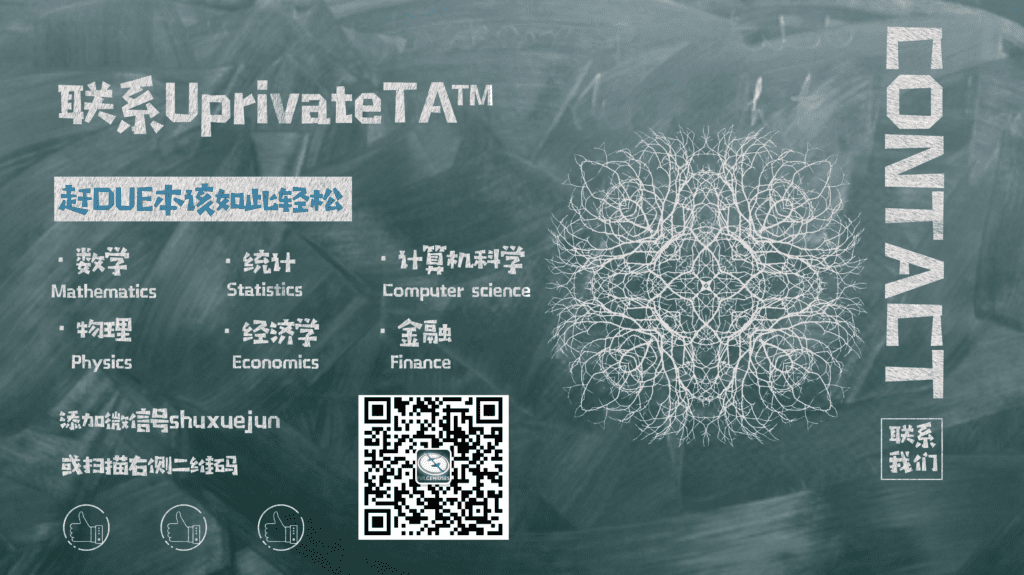如果你也在 怎样代写三维成像Three-Dimensional Imaging BMES621这个学科遇到相关的难题,请随时右上角联系我们的24/7代写客服。三维成像Three-Dimensional Imaging像是一种将许多扫描(来自计算机断层扫描、核磁共振或超声扫描)通过计算结合起来的技术。然后,这些图像可以由放射科医师或医生进行操作,以帮助诊断和手术计划。
三维成像Three-Dimensional Imaging是一种革命性的光学成像技术,它通过利用三维成像模式提供身体内部的放大图像进行医学分析。三维成像技术包括超声、磁共振成像(MRI)、放射成像和计算机断层扫描(CT)。成像是正畸医生评估和记录颅面结构的大小和形态的最重要工具之一。正畸医生通常使用二维(2D)静态成像技术,但二维成像无法获得和定位结构的深度。三维(3D)成像技术在20世纪90年代初得到发展,并在口腔医学,特别是正畸学中获得了宝贵的地位。本文献综述的目的是总结三维成像技术的现状,并评估其在正畸领域的应用。
三维成像Three-Dimensional Imaging代写,免费提交作业要求, 满意后付款,成绩80\%以下全额退款,安全省心无顾虑。专业硕 博写手团队,所有订单可靠准时,保证 100% 原创。最高质量的三维成像Three-Dimensional Imaging作业代写,服务覆盖北美、欧洲、澳洲等 国家。 在代写价格方面,考虑到同学们的经济条件,在保障代写质量的前提下,我们为客户提供最合理的价格。 由于作业种类很多,同时其中的大部分作业在字数上都没有具体要求,因此三维成像Three-Dimensional Imaging作业代写的价格不固定。通常在专家查看完作业要求之后会给出报价。作业难度和截止日期对价格也有很大的影响。
海外留学生论文代写;英美Essay代写佼佼者!
EssayTA™有超过2000+名英美本地论文代写导师, 覆盖所有的专业和学科, 每位论文代写导师超过10,000小时的学术Essay代写经验, 并具有Master或PhD以上学位.
EssayTA™在线essay代写、散文、论文代写,3分钟下单,匹配您专业相关写作导师,为您的留学生涯助力!
我们拥有来自全球顶级写手的帮助,我们秉承:责任、能力、时间,为每个留学生提供优质代写服务
论文代写只需三步, 随时查看和管理您的论文进度, 在线与导师直接沟通论文细节, 在线提出修改要求. EssayTA™支持Paypal, Visa Card, Master Card, 虚拟币USDT, 信用卡, 支付宝, 微信支付等所有付款方式.
想知道您作业确定的价格吗? 免费下单以相关学科的专家能了解具体的要求之后在1-3个小时就提出价格。专家的 报价比上列的价格能便宜好几倍。
想知道您作业确定的价格吗? 免费下单以相关学科的专家能了解具体的要求之后在1-3个小时就提出价格。专家的 报价比上列的价格能便宜好几倍。

电子工程代写|三维成像代写Three-Dimensional Imaging代考|Circular Motion in a Transverse Plane
Here we take again $\zeta=\zeta_0$ and now we have $\left|\boldsymbol{\rho}_t\right|^2=R^2$, where $R$ is the radius of the trajectory and $\mathbf{r}_t \cdot \rho_t=R|\mathbf{r}| \cos \left(\phi_0+\Omega t\right.$, where $\Omega$ is the angular velocity of the source and $\phi_0$ is some initial position. Substitution into Eq. $2.9$ yields
$$
\begin{aligned}
I_r(\mathbf{r})=& C \int_0^T \exp \left[-j k \zeta_0\right] \exp \left[\frac{-j k\left|\mathbf{r}_t\right|^2}{2 \zeta_0}\right] \
& \times \exp \left[-j k \frac{R^2}{2 \zeta_0}\right] \exp \left[j k \frac{R\left|\mathbf{r}_t\right| \cos \left(\phi_0+\Omega t\right)}{\zeta_0}\right] d t
\end{aligned}
$$
Again absorbing all constant factors in the constant $C$, we may simplify this relation to
$$
I_r(\mathbf{r})=C \exp \left[\frac{-j k\left|\mathbf{r}_t\right|^2}{2 \zeta_0}\right] \int_0^T \exp \left[j k \frac{R\left|\mathbf{r}_t\right| \cos \left(\phi_0+\Omega t\right)}{\zeta_0}\right] d t
$$
For long exposures the initial phase is irrelevant and the integral reduces to a Bessel function:
$$
I_r(\mathbf{r})=C \exp \left[\frac{-j k\left|\mathbf{r}_t\right|^2}{2 \zeta_0}\right] J_0\left(k R\left|\mathbf{r}_t\right|\right)
$$
The quadratic phase factor that multiplies this Bessel function is equivalent to a lens of focal length $\zeta_0$. Thus, illumination with a plane wave generates the Fourier transform of the Bessel function, which is the original circular trajectory.
电子工程代写|三维成像代写Three-Dimensional Imaging代考|ANALOGIES TO CODED APERTURE IMAGING
The use of a reference beam coherent with each object beam allowed the coherent summation of those object beams. This is what converted the moving Airy pattern into a sinc pattern, for example. We now wish to remove some of those restrictions. Suppose there were no reference beam at all. Then, obviously, the recorded pattern would be a blur from each point. This is of no interest whatever. By adding a local reference beam to the object beam from a point near the hologram, we were able to prevent exposure of much of the hologram at any instant. This meant that we lost coherence between points. Thus, we have called this the incoherent case. It is the nature of a world line to lose information on the temporal dimension. The hologram is the same regardless of the order in which the points were recorded. In fact, all of them may have been recorded at once so far as we can tell from the hologram. These observations allow us to identify these incoherent world line holograms with a different type of hologram – a coded aperture imaging record.
Coded aperture imaging began in the early 1960s with the work of Mertz [7]. It was intended to form images of mutually incoherent object beams. The idea was to let each object cast a shadow onto the recording plane and the mask used before the shadow casting was a Fresnel zone plate. Consider a single point source. As the point moves laterally, so does its shadow. As the point gets closer to the recording plane, its shadow gets bigger. Therefore, the three spatial coordinates of the point are encrypted in the recording. In addition, shining monochromatic light at the transparent record will decrypt that information automatically. Early on, we called this holography by shadow casting $[8]$.
Now we understand that coded aperture imaging is a kind of world line hologram. The only difference from our near-hologram recording is that in coded aperture imaging all of the points are present at once.
Making that identification allows us to benefit from roughly 35 years of research on coded aperture imaging. This is especially true when we think of computer-generated world line holograms. Each point can be replaced by its own characteristic pattern, properly scaled and translated. One of the enabling “tricks” of coded aperture imaging is the use of off-axis Fresnel zone plate with a special linear (Ronchi) grating near the object [9]. This allows off-axis reconstruction. The analogy between this and our chopping experiment is obvious. Alternatively, we can use the negative of the traditional zone plate to allow some cancellation of the undiffracted light in on-axis reconstruction [10].
Quite independently of either our optical work or coded aperture imaging, the digital computer hologram group in Essen has designed point-by-point holograms for display [11]. They even used the technique of limiting the extent of the reference beam to reduce the demands on dynamic range of the recording material for near-hologram-plane points. Just as we did, they got very satisfactory displays of the patterns so recorded.

三维成像代写
电子工程代写|三维成像代写三维成像代考|横平面的圆周运动
这里我们再次取$\zeta=\zeta_0$,现在我们有$\left|\boldsymbol{\rho}_t\right|^2=R^2$,其中$R$是轨迹的半径,$\mathbf{r}_t \cdot \rho_t=R|\mathbf{r}| \cos \left(\phi_0+\Omega t\right.$,其中$\Omega$是源的角速度,$\phi_0$是某个初始位置。代入Eq. $2.9$得到
$$
\begin{aligned}
I_r(\mathbf{r})=& C \int_0^T \exp \left[-j k \zeta_0\right] \exp \left[\frac{-j k\left|\mathbf{r}_t\right|^2}{2 \zeta_0}\right] \
& \times \exp \left[-j k \frac{R^2}{2 \zeta_0}\right] \exp \left[j k \frac{R\left|\mathbf{r}_t\right| \cos \left(\phi_0+\Omega t\right)}{\zeta_0}\right] d t
\end{aligned}
$$
再次吸收常数$C$中的所有常数因子,我们可以将这个关系简化为
$$
I_r(\mathbf{r})=C \exp \left[\frac{-j k\left|\mathbf{r}_t\right|^2}{2 \zeta_0}\right] \int_0^T \exp \left[j k \frac{R\left|\mathbf{r}_t\right| \cos \left(\phi_0+\Omega t\right)}{\zeta_0}\right] d t
$$
对于长时间曝光,初始相位无关,积分简化为贝塞尔函数:
$$
I_r(\mathbf{r})=C \exp \left[\frac{-j k\left|\mathbf{r}_t\right|^2}{2 \zeta_0}\right] J_0\left(k R\left|\mathbf{r}_t\right|\right)
$$
乘以这个贝塞尔函数的二次相位因子相当于一个焦距为$\zeta_0$的透镜。因此,平面波的照射产生贝塞尔函数的傅里叶变换,这是原始的圆形轨迹
电子工程代写|三维成像代写三维成像代考|ANALOGIES TO CODED APERTURE Imaging
使用与每个目标光束相干的参考光束,允许对这些目标光束进行相干求和。例如,这就是将移动的艾里模式转换为sinc模式的原因。我们现在希望取消其中一些限制。假设根本没有参考光束。那么,很明显,从每个点上记录的模式都是模糊的。这一点都不有趣。通过从靠近全息图的点向物体光束添加一个局部参考光束,我们能够防止全息图的大部分在任何时刻暴露。这意味着我们失去了点之间的连贯性。因此,我们称之为非连贯情况。丢失时间维度的信息是世界线的本质。全息图是相同的,不管点的记录顺序如何。事实上,就我们从全息图所知,所有这些可能都是同时被记录下来的。这些观测使我们能够用一种不同类型的全息图——编码孔径成像记录来识别这些非相干世界线全息图
编码孔径成像始于20世纪60年代初默茨的工作。它的目的是形成相互不连贯的物体光束的图像。这个想法是让每个物体在记录平面上投射阴影,在阴影投射之前使用的遮罩是菲涅尔带板。考虑单点源。当点横向移动时,它的影子也横向移动。当点离记录平面越近,它的影子就越大。因此,在记录中加密了点的三个空间坐标。此外,用单色光照射透明记录会自动解密这些信息。早期,我们称这为投影全息摄影$[8]$。
现在我们知道编码孔径成像是一种世界线全息图。与我们的近全息记录的唯一区别是,在编码孔径成像中,所有的点都是同时出现的
通过这种识别,我们可以从大约35年的编码孔径成像研究中获益。当我们想到计算机生成的世界线全息图时,尤其如此。每个点都可以被它自己的特征模式所取代,适当地缩放和转换。编码孔径成像的实现“技巧”之一是使用离轴菲涅尔带板,在物体[9]附近使用特殊的线性(Ronchi)光栅。这允许离轴重建。这和我们的剁肉实验有明显的相似之处。或者,我们可以使用传统区域板的负片,在轴上重建[10]时,允许一些未绕射光的抵消。完全独立于我们的光学工作或编码孔径成像,埃森的数字计算机全息图小组设计了用于显示的逐点全息图。他们甚至采用了限制参考光束范围的技术,以减少记录材料对近全息平面点的动态范围的要求。正如我们所做的那样,他们得到了非常令人满意的模式显示。

电子工程代写|三维成像代写Three-Dimensional Imaging代考 请认准UprivateTA™. UprivateTA™为您的留学生涯保驾护航。
微观经济学代写
微观经济学是主流经济学的一个分支,研究个人和企业在做出有关稀缺资源分配的决策时的行为以及这些个人和企业之间的相互作用。my-assignmentexpert™ 为您的留学生涯保驾护航 在数学Mathematics作业代写方面已经树立了自己的口碑, 保证靠谱, 高质且原创的数学Mathematics代写服务。我们的专家在图论代写Graph Theory代写方面经验极为丰富,各种图论代写Graph Theory相关的作业也就用不着 说。
线性代数代写
线性代数是数学的一个分支,涉及线性方程,如:线性图,如:以及它们在向量空间和通过矩阵的表示。线性代数是几乎所有数学领域的核心。
博弈论代写
现代博弈论始于约翰-冯-诺伊曼(John von Neumann)提出的两人零和博弈中的混合策略均衡的观点及其证明。冯-诺依曼的原始证明使用了关于连续映射到紧凑凸集的布劳威尔定点定理,这成为博弈论和数学经济学的标准方法。在他的论文之后,1944年,他与奥斯卡-莫根斯特恩(Oskar Morgenstern)共同撰写了《游戏和经济行为理论》一书,该书考虑了几个参与者的合作游戏。这本书的第二版提供了预期效用的公理理论,使数理统计学家和经济学家能够处理不确定性下的决策。
微积分代写
微积分,最初被称为无穷小微积分或 “无穷小的微积分”,是对连续变化的数学研究,就像几何学是对形状的研究,而代数是对算术运算的概括研究一样。
它有两个主要分支,微分和积分;微分涉及瞬时变化率和曲线的斜率,而积分涉及数量的累积,以及曲线下或曲线之间的面积。这两个分支通过微积分的基本定理相互联系,它们利用了无限序列和无限级数收敛到一个明确定义的极限的基本概念 。
计量经济学代写
什么是计量经济学?
计量经济学是统计学和数学模型的定量应用,使用数据来发展理论或测试经济学中的现有假设,并根据历史数据预测未来趋势。它对现实世界的数据进行统计试验,然后将结果与被测试的理论进行比较和对比。
根据你是对测试现有理论感兴趣,还是对利用现有数据在这些观察的基础上提出新的假设感兴趣,计量经济学可以细分为两大类:理论和应用。那些经常从事这种实践的人通常被称为计量经济学家。
MATLAB代写
MATLAB 是一种用于技术计算的高性能语言。它将计算、可视化和编程集成在一个易于使用的环境中,其中问题和解决方案以熟悉的数学符号表示。典型用途包括:数学和计算算法开发建模、仿真和原型制作数据分析、探索和可视化科学和工程图形应用程序开发,包括图形用户界面构建MATLAB 是一个交互式系统,其基本数据元素是一个不需要维度的数组。这使您可以解决许多技术计算问题,尤其是那些具有矩阵和向量公式的问题,而只需用 C 或 Fortran 等标量非交互式语言编写程序所需的时间的一小部分。MATLAB 名称代表矩阵实验室。MATLAB 最初的编写目的是提供对由 LINPACK 和 EISPACK 项目开发的矩阵软件的轻松访问,这两个项目共同代表了矩阵计算软件的最新技术。MATLAB 经过多年的发展,得到了许多用户的投入。在大学环境中,它是数学、工程和科学入门和高级课程的标准教学工具。在工业领域,MATLAB 是高效研究、开发和分析的首选工具。MATLAB 具有一系列称为工具箱的特定于应用程序的解决方案。对于大多数 MATLAB 用户来说非常重要,工具箱允许您学习和应用专业技术。工具箱是 MATLAB 函数(M 文件)的综合集合,可扩展 MATLAB 环境以解决特定类别的问题。可用工具箱的领域包括信号处理、控制系统、神经网络、模糊逻辑、小波、仿真等。